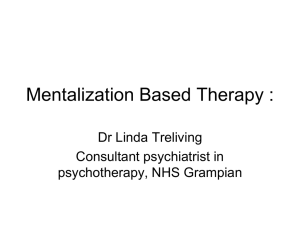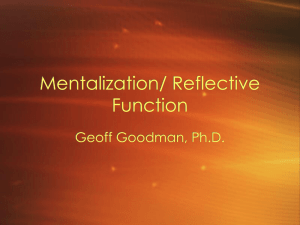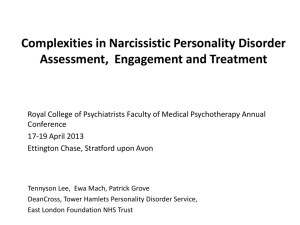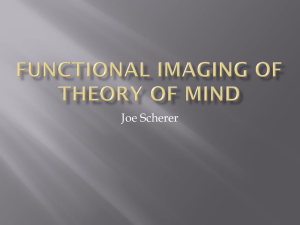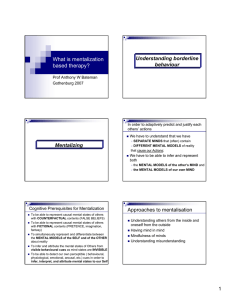Introduction to Mentalization
advertisement
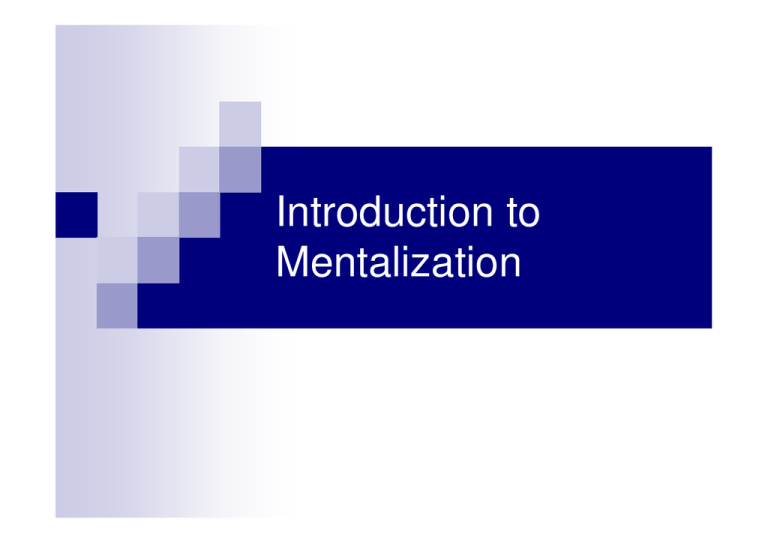
Introduction to Mentalization Forewarning In advocating mentalization-based treatment we claim no innovation. On the contrary, mentalization-based treatment is the least novel therapeutic approach imaginable: it addresses the bedrock human capacity to apprehend mind as such. Holding mind in mind is as ancient as human relatedness and self-awareness. —. Chichester: J. Wiley, 2006 Some Free Publicity JUST RELEASED! NEW! IMPROVED! Washes brains whiter! Longer than all previous versions! 2012 American Psychiatric Publishing, Inc For further Information p.fonagy@ucl.ac.uk anthony@mullins.plus.com All slides available at: http://www.ucl.ac.uk/psychoanalysis/unitstaff/staff.htm Bateman, A and Fonagy, P (2006) Mentalization Based Treatment – a practical guide OUP: Oxford Allen, J, Fonagy, P and Bateman, A (2008) Mentalizing in Clinical Practice APPI Washington Exercise – mentalization or mentalizing? What is mentalization or mentalizing? Give 3 key aspects of the psychological processes that the concept tries to encapsulate Should we use mentalization or mentalizing? What is mentalizing? Mentalizing is a form of imaginative mental activity about others or oneself, namely, perceiving and interpreting human behaviour in terms of intentional mental states (e.g. needs, desires, feelings, beliefs, goals, purposes, and reasons). What I don’t like about mentalizing Off-putting jargon for a concept intended to capture the essence of our humanity Sounds too cognitive and intellectual, ironic when (a) we are most keen to promote mentalizing of emotion and mentalizing in the midst of emotional states (e.g., “holding heart and mind in heart and mind” captures the spirit better than holding mind in mind) (b) a lot of mentalizing is not conscious, deliberate, and reflective but rather automatic, intuitive, and implicit Concept is too broad and all-encompassing such that it can explain virtually anything; we need to focus on different facets of mentalizing What I like about mentalizing An unusual word that captures attention, not simply assimilated into current concepts (e.g., empathy) Breadth of the concept gets therapists and patients in the general ballpark Helpful to have a verb (as contrasted with mindfulness, psychological mindedness, metacognition, and “mentalization”)— emphasizes agency, something we aspire to do more skillfully No exact synonym despite many related concepts A common mentalizing failure I love this story told by the mother of a five-year-old girl. The child had taken a stethoscope out of her mother’s doctor bag and was playing with it. As she put the stethoscope to her ears, her mother thought proudly, She seems interested in medicine. Maybe she will grow up and become a doctor like me. After a time the little girl put the listening end of the stethoscope up to her mouth and exclaimed, ‘Welcome to McDonald’s. May I take your order, please?’ At this, the mother had to laugh with her daughter, and smiled to herself about how easily we can project our ideas on one another. Kornfield, The wise heart — SYSTEMIC: The value of understanding the relationship between the thoughts and feelings of family members and their behaviours, and the impact of these on each other. CBT: The value of understanding the relationship between my thoughts and feelings and my behaviour. COMMON Mentalizing as an Integrative framework PSYCHODYNAMIC: The value of Understanding the nature of resistance to therapy, and the dynamics of here-and-now in the therapeutic relationship. LANGUAGE SOCIAL ECOLOGICAL: The value of understanding the impact of context upon mental states; deprivation, hunger, fear, etc... Mindblindness Imagine what your world would be like if you were aware of physical things but were blind to the existence of mental things. I mean of course blind to things like thoughts, beliefs, knowledge, desires, and intentions, which for most of us selfevidently underlie behaviour Baron-Cohen S (1995) Mindblindness The Artful use of Science To do anything well you must have the humility to bumble around a bit, to follow your nose, to get lost, to goof. Have the courage to try an undertaking and possibly do it poorly. Unremarkable lives are marked by the fear of not looking capable when trying something new. Epictetus, Manual Mentalizing: A new word for an ancient concept Implicitly and explicitly interpreting the actions of oneself and other as meaningful on the basis of intentional mental states (e.g., desires, needs, feelings, beliefs, & reasons) Introduction to theory of mentalisation The normal ability to ascribe intentions and meaning to human behaviour Ideas that shape interpersonal behaviour Make reference to emotions, feelings, thoughts, intentions, desires Shapes our understanding of others and ourselves Central to human communication and relationships Underpins clinical understanding, the therapeutic relationship and therapeutic change Mentalizing: further definitions and scope To see ourselves from the outside and others from the inside Understanding misunderstanding Having mind in mind Past, present, and future Introspection for subjective selfconstruction – know yourself as others know you but also know your subjective self Characteristics of mentalising Central concept is that internal states (emotions, thoughts, etc) are opaque We make inferences about them But inferences are prone to error Overarching principal is to take the “inquisitive stance” = Interpersonal behaviour characterised by an expectation that one’s mind may be influenced, surprised, changed and enlightened by learning about another’s mind Mentalization and Overlapping Constructs (Choi-Kain & Gunderson, Am J Psychiat 2008) Mindfulness Keeping one’s consciousness alive to the present reality Observing and describing one’s own experience whilst participating non-judgementally Two domains Attention regulation Acceptance and openness to experience Four Skills Observing Describing Acting with awareness Accepting without judgement Mentalisation and conceptual cousins Component Mindfulness Psychological Mindedness Empathy Affect consciousness Implicit No No Yes No Explicit yes Yes Yes Yes Selforientated Yes Yes Minimal Yes Other orientated No Minimal Yes Yes Cognitive/ Affect Cog=Affect Cog=Affect Affect>Cog Affect>Cog Multiple dimensions of mentalizing in psychodynamic psychotherapy Differentiating self and other in psychotherapy Adopting the perspective of the other to the self Reducing the impact of the other on the self Moving from implicit - automatic mentalization to explicit – controlled mentalization Challenging automatic assumptions Elaborating internal representations of mental states of self and others - external and internal mentalizing Challenging superficial judgements based on ‘appearances’ Connect feelings with thoughts (affect and cognition) Overcoming splitting of affect and cognition (the feeling of feelings) Treatment vectors in re-establishing mentalizing in borderline personality disorder ImplicitAutomatic Impression Controlled driven Appearance Inference Mental interior focused Certainty emotion Doubt of of cognition Cognitive agent:attitude propositions Imitative frontoparietal mirror neurone system ExplicitControlled Emotional contagion Autonomy Mental exterior focused Affective self:affect state propositions Belief-desire MPFC/ACC inhibitory system Mayes’ (2001) Adaptation of Arnsten’s Dual Arousal Systems Model: Implication of the Hyper-activation of Attachment Prefrontal capacities Performance Posterior cortex and subcortical capacities Changing switchpoint threshold Point 1a Point 1 Low High Arousal Parallel contributions to mentalizing: Meeting of minds attachment & arousal PATIENT mentalization attachment & arousal mentalizing Developmental competence Current performance HEALTH CARE SYSTEM mentalizing Current performance attachment & arousal CLINICIAN mentalization attachment & arousal Developmental competence Dimensions of mentalization: implicit/automatic vs explicit/controlled Psychological understanding drops and is rapidly replaced by confusion about mental states under high arousal That handkerchief which I so loved and gave thee Thou gavest to Cassio. By heaven, I saw my handkerchief in's hand. Controlled Automatic Arousal Dimensions of mentalization: implicit/automatic vs explicit/controlled Psychotherapist’s demand to explore issues that trigger intense emotional reactions involving conscious reflection and explicit mentalization are inconsistent with the patient’s ability to perform these tasks when arousal is high Arousal Dimensions of mentalization: internally vs externally focused (mental interiors vs visible clues) Internal I wonder if he feels his mother loved him? External He looks tired; perhaps he slept badly With selective loss of sense of mental interiors, external features are given inappropriate weight and misinterpreted as indicating dispositional states You’re covering your eyes; you can hardly bear to look at me Dimensions of mentalization: Cognitive vs affective mentalization Cognition Agent attitude propositions ‘I think he thought that Charlie ate his chocolate’ Associated with several areas of prefrontal cortex Emotion Self affect state propositions ‘I feel upset about it’ Associated with inferior prefrontal gyrus Dimensions of mentalization: Cognitive vs affective mentalization With diminution of cognitive mentalization the logic of emotional mentalization (self- affect state proposition) comes to be inappropriately extended to cognitions. “I feel sad, you must have hurt me” Failures of imagination in mindblindness Dehumanising Subjectivity & humanity Demonizing Concrete & Egocentric Restrained imagination Imaginary & projective Mentalizing Distorted mentalizing Non-mentalizing Mentalizing: Implicit ‘v’ Explicit IMPLICIT Perceived Nonconscious Nonverbal Unreflective e.g. mirroring EXPLICIT Interpreted Conscious Verbal Reflective e.g. explaining Mentalizing interactively and emotionally Mentalizing interactively Each person has the other person’s mind in mind (as well as their own) Self-awareness + other awareness Mentalizing emotionally Mentalizing in midst of emotional states Feeling and thinking about feeling (mentalized affectivity) Feeling felt Example of mentalizing interactively and emotionally The appetite which we call LUST is a sensual pleasure, but not only that; there is in it also a delight of the mind: for it consisteth of two appetites together, to please, and to be pleased; and the delight (we) take in delighting, is not sensual, but a pleasure of joy of the mind, consisting in the imagination of the power (we) have so much to please. Thomas Hobbes, quoted in Simon Blackburn (2004) Lust Mentalizing and psychopathy: Compart-mentalization Psychopathy entails elements of intact mentalizing Partial mindblindness: Failure of imaginative empathy Failure to identify with victim’s distress Mind uninfluenced and unchanged easily – control and protection of self from shame/humiliation paramount Distorted mentalizing – paranoid demonizing e.g. interpreting the child’s frustrating behaviour as intended to torment the parent Mentalizing objects and others Our relations with other people do not have the same structure as our relations with inanimate objects, plants or machines. We do not deal with our family members, friends, colleagues or fellow citizens, as we do with volcanoes, fields of wheat or kitchen mixers, namely, by trying to figure out the nature and layout of their innards so that we can predict and perhaps control them. What we hope of another with whom we interact is not that he or she will go through some gyrations which we have already planned in detail, but that he or she will make some contributions to moving forward the joint and cooperative enterprise in which we are both, more of less explicitly, engaged Heal, J (2003) Mind, Reason and Imagination: Selected Essays in Philosophy of Mind and Language CUP: Cambridge. Being misunderstood Although skill in reading minds is important, recognising the limits of one’s skill is essential First, acting on false assumptions causes confusion Second, being misunderstood is highly aversive Being misunderstood generates powerful emotions that result in coercion, withdrawal, hostility, over protectiveness, rejection Mentalization: Some theory What is it? How does it arise? Why does it matter? How do we use it in therapy? Brains and social behavior vary across different mammalian species Insectivors: Regulated maternal behaviors Chimpanzees: Societies of a few dozen Modern Humans: Societies of millions of interacting people Humans exceedingly skilled at large scale social interaction Competition for social skills led to the evolutions of cognitive mechanism for collaborating with others Fuelled evolution of human brain. Therefore correlation in mammals between size of social group and volume of neocortex The uniqueness of homo sapiens No animal, not even the most intelligent of non-human primates, can discern the difference between the act of a conspecific due to serendipity and one rooted in intention, wish, belief or desire. The capacity to mentalize has also been argued to account for the other major difference between humans and other apes: self awareness and self-consciousness as a path to emulation bringing with it social emotions such as embarrassment, shame and guilt the species specific striving to be more than a ‘beast’, to live beyond one’s body, to aspire to a spirit that transcends physical reality and step beyond one’s own existence social origin of the self (simulation). A working definition of mentalization Mentalizing is a form of imaginative mental activity, namely, perceiving and interpreting human behaviour in terms of intentional mental states (e.g. needs, desires, feelings, beliefs, goals, purposes, and reasons). Mentalizing: further definitions and scope for thinking about it To see ourselves from the outside and others from the inside Understanding misunderstanding Having mind in mind Being mind minded Being mindful (of minds) Past, present, and future Seeing oneself as agentive an intentional being Creating phenomenological coherence about self and others Mentalization and Overlapping Constructs (Choi-Kain & Gunderson, Am J Psychiat 2008) The brain and social understanding The social brain: A variety of studies stories, sentences, cartoon, animations medial prefrontal cortex (mPFC), temporo-parietal junction (TPJ), posterior superior temporal sulcus (pSTS), amygdala, anterior cingulate cortex (ACC), anterior insula (AI), inferior frontal gyrus (IFG) and interparietal sulcus (IPS) Mentalizing: Cognitive vs. Emotional Emotional Mentalizing The capacity to experience affective reactions to the observed experiences of others Cognitive Mentalizing Role-taking ability: The capacity to engage in the cognitive process of adopting another’s psychological point of view. Making inferences regarding the other’s affective and cognitive mental states Mentalizing brain networks M E N T A L I Z I N G Shamay-Tsoory 2011 Multifaceted Nature of Mentalization Fonagy, P., & Luyten, P. (2009). Development and Psychopathology, 21, 1355-1381. Implicitamygdala, basal ganglia, Automaticventromedial prefrontal Non -conscious- cortex (VMPFC), lateral temporal cortex (LTC) Immediate. and the dorsal anterior Mental interior cue focused Cognitive agent:attitude propositions Imitative frontoparietal mirror neurone system lateral and medial prefrontal cortex (LPFC & MPFC), lateral and medial parietal cortex (LPAC & MPAC), medial temporal lobe (MTL),rostral anterior cingulate cortex (rACC) cingulate cortex (dACC) medial frontoparietal network activated Associated with several areas of prefrontal cortex frontoparietal mirror-neuron system recruits lateral fronto-temporal network Associated with inferior prefrontal gyrus the medial prefrontal cortex, ACC, and the precuneus ExplicitControlled Conscious Reflective Mental exterior cue focused Affective self:affect state propositions Belief-desire MPFC/ACC inhibitory system Imbalance of mentalization generates problems Fonagy, P., & Luyten, P. (2009). Development and Psychopathology, 21, 1355-1381. BPD ImplicitExplicitImpulsive, quick assumptions Does not genuinely appreciate others’ AutomaticControlled about others thoughts and feelings perspective. Pseudo-mentalizing, Non -conscious- not reflected on or tested, cruelty Interpersonal conflict ‘cos hard to Conscious consider/reflect on impact of self Immediate. Reflective on others BPD Mental Mental interior cue focused Hyper-vigilant, judging by appearance. Evidence for attitudes and other internal states hasto come from outside Lack of conviction about own ideas Seeking external reassurance Overwhelming emptiness, Seeking intense experiences exterior cue focused BPD Cognitive agent:attitude propositions Imitative frontoparietal mirror neurone system Unnatural certainty about ideas Anything that is thought is REAL Intolerance of alternative ways of seeing things. Affective Overwhelming dysregulated emotions, self:affect state Not balanced by cognition come propositions To dominate behavior. Lack of contextualizing of feelings leads to catastrophyzing BPD Hypersensitive to others’ Moods, what others say. Fears ‘disappearing’ Rigid assertion of self, controlling others’ thoughts and feelings. Belief-desire MPFC/ACC inhibitory system Prementalizing Modes of Subjectivity Psychic equivalence: Mind-world isomorphism; mental reality = outer reality; internal has power of external Intolerance of alternative perspectives concrete understanding Reflects domination of self:affect state thinking with limited internal focus Managed by avoiding being drawn into non-mentalizing discourse Pretend mode: Ideas form no bridge between inner and outer reality; mental world decoupled from external reality “dissociation” of thought, hyper-mentalizing or pseudo-mentalizing Reflects explicit mentalizing being dominated by implicit, inadequate internal focus, poor belief-desire reasoning and vulnerability to fusion with others Managed in therapy by interrupting a non-mentalizing process Teleological stance: A focus on understanding actions in terms of their physical as opposed to mental constraints Cannot accept anything other than a modification in the realm of the physical as a true index of the intentions of the other. Extreme exterior focus, momentary loss of controlled mentalizing Misuse of mentalization for teleological ends (harming others) becomes possible because of lack of implicit as well as explicit mentalizing Attachments and the development of social understanding Measuring Mentalization (Baron(Baron-Cohen et al., 2001) Reading the Mind in the Eyes Test Friendly - A Surprised - C Sad - B Worried - D Measuring Mentalization (Baron-Cohen et al., 2001) Reading the Mind in the Eyes Test SurprisedSurprised-A JokingJoking-C Sure about somethingsomething-B HappyHappy-D Measuring Mentalization (Baron(Baron-Cohen et al., 2001) Reading the Mind in the Eyes Test JokingJoking-A FlusteredFlustered-B DesireDesire-C ConvincedConvinced-D Mentalizing at the World Cup: How does Robert Green feel after letting in the USA goal? Upset Disappointed Angry Frustrated Shared neural circuits for mentalizing about the self and others (Lombardo et al., 2009; J. Cog. Neurosc.) Self mental state Other mental state Overlapping for Self and Other Relational Aspects of Mentalization Overlap between neural locations of mentalizing self and other may be linked to intersubjective origin of sense of self We find our mind initially in the minds of our parents and later other attachment figures thinking about us The parent’s capacity to mirror effectively her child’s internal state is at the heart of affect regulation Infant is dependent on contingent response of caregiver which in turn depends on her capacity to be reflective about her child as a psychological being Failure to find the constitutional self in the other has potential to profoundly distort the self representation (exaggerated mirroring of child’s anxiety aggravates anxiety rather than soothe) The same applies to child with inadequate sense of independent self within therapeutic relationship How Attachment Links to Affect Regulation DISTRESS/FEAR BONDING Down Regulation of Emotions Exposure to Threat Activation of attachment EPISTEMIC TRUST Proximity seeking The forming of an attachment bond Attachment Disorganisation in Disrupted Early Relationships DISTRESS/FEAR Exposure to threat Adverse Emotional Experience Activation of attachment Proximity seeking The ‘hyperactivation’ of the attachment system The two-dimensional space defined by attachment anxiety and avoidance, showing Bartholomew’s 4 categories High avoidance Dismissing avoidant -ve view of other Fearful avoidant Low anxiety High anxiety +ve view of self -ve view of self Secure Preoccupied Low avoidance +ve view of other High congruent & marked mirroring Mirroring must not be too accurate, it must be ‘marked’ (systematically distorted) so child knows he is not observing caregiver’s dispositional state Unmarked mirroring Marked mirroring Affect & Self Regulation Through Representation Mirroring Psychological Self: 2nd Order Representations of self-state: Internalization of object’s image Expression symbolic organisation of internal state Physical Self: Primary Representations Constitutional self in state of arousal Infant Fonagy, Gergely, Jurist & Target (2002) With apologies to Gergely & Watson (1996) Reflection Resonance CAREGIVER Theory: Birth of the Agentive Self Attachment figure “discovers” infant’s mind (subjectivity) Internalization Representation of infant’s mental state Core of psychological self Attachment figure Inference Infant Infant internalizes caregiver’s representation to form psychological self Safe, playful interaction with the caregiver leads to the integration of primitive modes of experiencing internal reality mentalization The stable instability and predictable unpredictability of BPD Crucial role of Attachment History in facilitating/inhibiting Mentalization in the face of stress Arousal/stress inhibits controlled (‘reflective’) mentalization This leads to automatic mentalizing dominated by reflexive (unrerflective) assumptions regarding self and others under stress, which may not be obvious in low stress conditions Reemergence of non-mentalizing modes Luyten, P., Mayes, L. C., Fonagy, P., & Van Houdenhove, B. (2010). The interpersonal regulation of stress: A developmental framework. Manuscript submitted for publication. Fonagy, P., & Luyten, P. (2009). A developmental, mentalization-based approach to the understanding and treatment of borderline personality disorder. Development and Psychopathology, 21(4), 1355-1381. Fonagy, P., Luyten, P., Bateman, A., Gergely, G., Strathearn, L., Target, M., et al. (2010). Attachment and personality pathology. In J. F. Clarkin, P. Fonagy & G. O. Gabbard (Eds.), Psychodynamic psychotherapy for personality disorders. A clinical handbook (pp. 37-87). Washington, DC: American Psychiatric Publishing. Dimensions of mentalization: implicit/automatic vs explicit/controlled in Othello That so loved Why, handkerchief how now, ho! fromwhich whenceIariseth this? and gave thee Thou to Cassio. Are wegavest turn'd Turks, and to ourselves do that Which heavenIhath Ottomites? By heaven, sawforbid my the handkerchief in's hand. For Christian shame, put by this barbarous brawl: Controlled Automatic Love Spurned/ Arousal Dimensions of mentalization: implicit/automatic vs explicit/controlled in Othello That handkerchief which I so loved and gave thee ThouLateral gavest to Cassio. PFC Amygdala temporal Lateral PFCmy Medial Ventromedial PFCin's hand. By heaven, I saw handkerchief cortex Controlled Automatic Arousal Dimensions of mentalization: implicit/automatic vs explicit/controlled Psychological understanding drops and is rapidly replaced by confusion about mental states under high arousal That handkerchief which I so loved and gave thee Thou gavest to Cassio. By heaven, I saw my handkerchief in's hand. Controlled Automatic Arousal Dimensions of mentalization: implicit/automatic vs explicit/controlled Psychotherapist’s demand to explore issues that trigger intense emotional reactions involving conscious reflection and explicit mentalization are inconsistent with the patient’s ability to perform these tasks when arousal is high Arousal The effect of attachment-related stress on the capacity to mentalize: Induction imagery scripts to 12 participants (Nolte, Hudac, Mayes, Fonagy & Pelphrey, 2009) • Scripts obtained in a visit prior to scanning with the aim to create stress-related arousal states • Idiosyncratic content, personally meaningful • Common themes attachment stress: e.g. relationship breakup, funeral etc. • Common themes normal stress: e.g. exam preparation, lost objects etc. • Edited, recorded, semi-standardized about 5 mins. of length each • Only scripts that were subjectively rated 8 or above on a 110 scale of subjective stress accepted. • No differences in subjective level of stress ratings between ‘attachment’ and ‘normal’ stress The effect of attachment-related stress on the capacity to mentalize: Modified Reading Mind in Eyes Nolte, Hudac, Mayes, Fonagy & Pelphrey (2013) Stimuli Subjects were asked to make a judgment as fast and accurately as possible Which attitude? Resentful Bored Which age? Twenty-three Thirty Examples of single trial stimuli, RMET (top), control task (bottom). Frontiers in Human Neuroscience,7, Article 816 The effect of attachment-related stress on the capacity to mentalize: Behavioral measures of impact of stress Nolte, Hudac, Mayes, Fonagy & Pelphrey (2013) Accuracy scores Frontiers in Human Neuroscience (2013), 7, Article 816 Baseline/ post normal stress: p= 0.03 Baseline/ post attachment stress: p=0.001 Post normal/ post attachment stress: p=0.01 70 60 50 40 30 20 10 0 Baseline post normal stress post attachment Attachment stress disrupts RMET performance more than normal stress! Regions differentially activated by mental-state and age judgments in the RMET-R administered with no previous stress induction. Nolte et al., 2013 Frontiers in Human Neuroscience (2013), 7, Article 816 Regions that showed differential activation between mental state and age judgments in the baseline RMET-R that were modulated by stress induction type. (Attachment related stress versus general stress) Nolte et al. (2013) Mental state judgments Age judgments ASI condition resulted in reduced mentalization-related activation in the left posterior superior temporal sulcus(STS),left inferior frontal gyrus and left temporoparietal junction(TPJ). Differential functional connectivity to the left posterior STS during mental state and age judgments after the ASI vs.the GSI. (Nolte et al., 2013) The left middle frontal gyrus and left anterior insula showed greater functional connectivity to the left posterior STS after the ASI. A biobehavioral switch model of the relationship between stress and controlled versus automatic mentalization (Based on Luyten et al., 2009) Attachment - Arousal/Stress Inhibition of social understanding associated with maltreatment can lead to exposure to further abuse DISTRESS/FEAR Adverse emotional experience rooted in traumatic relationships Intensification of attachment needs Inhibition of mentalisation Inaccurate judgements of affect, Delayed development of mentalization understanding Failure to understand how emotions relate to situations and behavior The mentalizing model of BPD Distal factors Constitutional Factors BPD: Core features Proximal factors Early caregiving context Stress/ arousal • • Hypersensitivity to mental states Attachment Disruptions • Low threshold for attachment activation & deactivation of MZ Poor selfother differentiation Impairments in integration of cognition & affect Dysfunctional relationships Affect dysregulation Impulsivity Pre-mentalizing modes of social cognition • • • Identity diffusion Dissociation Feelings of inner pain & emptiness Severe interpersonal difficulties as a consequence of disrupted mentalizing Theory: Birth of the “Alien” Self in Disorganized Attachment The caregiver’s perception is inaccurate or unmarked or both Attachment Child Mirroring fails The nascent self Figure Absence of a representation of the infant’s mental state representational structure The Alien Self Internalisation of a non-contingent mental state as part of the self The child, unable to “find” himself as an intentional being, internalizes a representation of the other into the self with distorted agentive characteristics which disorganizes the self creating splits within the self structure Theory: Self-destructiveness and Externalisation Following Adversity Torturing alien self Perceived other Self representation Unbearably painful emotional states: Self experienced as evil/hateful Self-harm state Attack from within is turned against body and/or mind. Theory: Self-destructiveness and Self-destructive relationships Torturing alien self Perceived other Self representation Unbearably painful emotional states: Self experienced as evil/hateful Self-harm state Torturing alien self Externalization Container Self Selfexperienced experienced asas hated evil and and attacked hateful Addictive bond Victimized state Projective identification is used to reduce the experience of unbearably painful emotional state of attack from within – externalisation becomes a matter of life and death and addictive bond and terror of loss of (abusing) object develops If someone was causing you pain or simply tormenting you, perhaps not everyday for the whole day, parts of a day, or for days and weeks on end, You could if you were brave or desperate enough, defend yourself, by perhaps attacking (and eliminating) your persecutor. But what if this thing you hate, was inhabiting your head? You can’t exactly say please leave my body, you can’t do anything to get it to just pack up and leave because technically, physically that isn’t possible. You can say fuck you. I hate you. You can self-harm with the hugest force your body can withstand, with all you can muster. You can do that. You can be very very angry and show them who’s boss, you won’t stand for it, you won’t take it lying down. You want to be heard, you want to say right, you think you can hurt me? I’ll show you, I’ll show you how much I can hurt you! But you and this thing, you are inhabiting one body. You attack this thing you attack yourself. You don’t have a choice though. That’s a sacrifice you make over and over. Eventually, you realise the only way to get rid of this thing, once and for all is getting rid of yourself. What choice do you really have? No doctor can specify the problem. No medication can fix the problem that can’t be specified. You fail to understand yourself. You can’t explain to your family and docs, they can’t help you because you do not talk. You doubt yourself “do I even have a problem?” People in real life often treat you like you don’t have a real problem. They talk to you stupidly, you complain that they don’t understand, you look a fool. Perhaps that is why you don’t talk to them anymore. Maybe you don’t have a problem anyway. You are a child, quite possibly you are just making this up for some attention, finding an excuse for why you can’t stay in college or get a job. Maybe you don’t have an excuse, you are just a stubborn little child. From what everyone tells you perhaps that is true. You have doubt. You are willing to listen to someone else. For now that is the only reason why you are not, at this moment trying to do it. Externalisation & Violence Following Trauma Torturing alien self Perceived other Self representation Unbearably painful emotional states: Self experienced as evil/hateful Self-harm state Torturing alien self Externalization Violent act Container Self Self Selfexperienced experienced experienced as as righteously as hated evil and andvindicated attacked hateful Addictive bond Violent state Projective identification is used to reduce the experience of unbearably painful emotional state of attack from within – externalisation becomes a matter of life and death, the violent act protects against experience of intrusion and addictive bond and terror of loss of abused object can develop Understanding suicide and self-harm in terms of the temporary loss of mentalization Loss Increase attachment needs triggering of attachment system Failure of mentalization Psychic equivalence intensification of unbearable experience Pretend mode hypermentalization meaninglessness, dissociation Teleological solutions to crisis of agentive self suicide attempts, self-cutting Assessment of Mentalization Understanding suicide and self-harm in terms of the temporary loss of mentalisation Figure 2.x Understanding BPD in terms of the suppression of mentalization Temporary Failure of Mentalisation Pretend Mode Pseudo Mentalisation Psychic Equivalence Teleological Mode Concrete Understanding Misuse of Mentalisation Unstable Interpersonal Relationships Affective Dysregulation Impulsive Acts of Violence, Suicide, Self-Harm Psychotic Symptoms Questions that can reveal quality of mentalisation why did your parents behave as they did during your childhood? do you think your childhood experiences have an influence on who you are today? any setbacks? did you ever feel rejected as a child? in relation to losses, abuse or other trauma, how did you feel at the time and how have your feelings changed over time? have there been changes in your relationship with your parents since childhood? Elaboration of interpersonal event Thoughts and feelings in relation to the event Ideas about the other person’s mental state at turning points in narrative Elaborate on actual experience Reflecting on reconstructed past Understanding own actions (actual past and reflection on past) Counter-factual follow-up questions Interpersonal interaction Last night Rachel and I had an argument about whether I was doing enough around the house. She thought I didn’t do as much as her and I should do more. I said I did as much as my work obligations allow. Rachel got angry and we stopped talking to each other. In the end I agreed to do the shopping from now on. But I ended up feeling furious with her What does non-mentalizing look like? Excessive detail to the exclusion of motivations, feelings or thoughts Focus on external social factors, such as the school, the council, the neighbours Focus on physical or structural labels (tired, lazy, clever, self-destructive, depressed, short-fuse) What does non-mentalizing look like? Preoccupation with rules, responsibilities, ‘shoulds’ and ‘should nots’ Denial of involvement in problem Blaming or fault-finding Expressions of certainty about thoughts or feelings of others What does good mentalizing look like? In relation to other peoples thoughts and feelings Acknowledgement of opaqueness Absence of paranoia Contemplation and reflection Perspective taking Genuine interest Openness to discovery Forgiveness predictability What does good mentalizing look like? Perception of own mental functioning Appreciation of changeability Developmental perspective Realistic scepticism Acknowledgement of pre-conscious function Awareness of impact of affect Self-presentation e.g. autobiographical continuity General values and attitudes e.g. tentativeness and moderation What does extremely poor mentalizing look like? Anti-reflective hostility active evasion non-verbal reactions Failure of adequate elaboration Complete lack of integration Complete lack of explanation Inappropriate Complete non-sequiturs Gross assumptions about the interviewer Literal meaning of words Assessment of mentalization Distinguish four main types of problem - not mutually exclusive; more than one may apply to the same person Concrete understanding o Generalised lack of mentalising Context-specific non-mentalising o Non-mentalising is variable and occurs in particular contexts Pseudo-mentalising o Looks like mentalising but missing essential features Misuse of mentalising o Others’ minds understood and thought about, but used to hurt, manipulate, control or undermine Concrete understanding General failure to appreciate feelings of self or others as well as the relationships between thoughts, feelings and actions General lack of attention to the thoughts, feelings and wishes of others and an interpretation of behaviour (own or others) in terms of the influence of situational or physical constraints rather than feelings and thoughts May vary markedly in degree Context Specific - Relational Dramatic temporary failures of mentalisation “You’re trying to drive me crazy” “You hate me” ‘She does my head in. I can’t think once she starts on me’ Pseudo-mentalising subtypes Intrusive mentalising Opaqueness of mental states not respected Thoughts and feelings talked about, may be relatively plausible and roughly accurate, but assumed without qualification Overactive-inaccurate mentalising Lots of effort made, preoccupation with mental states Off-the-mark and un-inquisitive Destructively inaccurate Denial of objective reality, highly psychologically implausible mental states inferred Misuse of Mentalizing (1) Understanding of the mental state of the individual is not directly impaired yet the way in which it is used is detrimental May be unconscious but is assumed to be motivated Self-serving distortion of the other’s feelings Self-serving empathic understanding A person’s feelings are exaggerated or distorted in the service of someone else’s agenda Misuse of Mentalizing(2) Coercion against or induction of the thoughts of others Deliberate undermining of a person’s capacity to think by humiliation Extreme form is sadistic or psychopathic use of knowledge of other’s feelings or wishes Milder form is manipulation for personal gain o inducing guilt o engendering unwarranted loyalty o power games o Understanding used as ammunition in a battle

